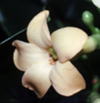SEARCH the
Gentian Research Network
and Rutgers University:
GENTIANS
Classification (newest)
List of genera
List by tribe
Gentian characteristics
Gentianales
RESEARCH
Research projects
People, addresses
Literature, publications
Links
Add info to
this site
TOPICS
Anatomy
Common names
Ecology - Natural history
GEOGRAPHY
Floras
Latin America
North America
TRIBES
Saccifolieae
_____________________
Information in other languages:
_____________________
This page
is maintained
by Dr.
Lena
Struwe
(e-mail),
and hosted by
Rutgers University, USA
updated: 01/19/11
| tribe
Potalieae (Gentianaceae) Overview of gentian tribal classification Classification
list
arranged by genus name |
 |
|
|
Species: About 150 species in 13 genera. Fagraea is the largest genus. Distribution: Tropical areas in South and Central America, Africa, Madagascar, Asia, Pacific, and northern Australia. Habitat: Rainforests, savannas, grasslands, less often roadsides and other disturbed habitats. Characteristics: Trees, lianas, shrubs, or herbs. Interpetiolar sheath or prominent line common in Anthocleista, Lisianthius, Potalia, and most Fagraea. Inflorescences are dichasial cymes, clusters, umbels, or flowers are solitarily. Flowers (3-)4-5(8-16)-merous. Stamens often with various appendages at their bases. Pistil is sessile, often with nectary disk at base. Stigma capitate, slightly bilobed, or broadly bilamellate. Fruit a capsule or fleshy berry. Evolution and related plants: The Potalieae is most closely related to the tribes Gentianeae and Helieae. Within Helieae, studies using molecular phylogenetic methods have shown that there are three major clades; The subtribe Faroinae (Enicostema, Neurotheca and related genera), the subtribe Lisianthiinae (Lisianthius only), and the subtribe Potaliinae (Anthocleista, Fagraea, and Potalia). Economic uses: Anthocleista and Potalia have many ethnobotanical uses, and are primarily used to treat fevers and inflammations. Fagraea is often used for decoration and perfumes, and some species are also used for timber. Notes: Anthocleista, Fagraea, and Potalia (= subtribe Potaliinae) were earlier included in the plant family Loganiaceae, but already Bureau (1856) suggested that they should be placed in the Gentianaceae. Data gathered from phylogenetic studies in the 1990's also placed these three genera inside the Gentianaceae and the transfer was made in 1994 (Struwe et al., 1994). These genera have many characters in common with the gentians, such as the presence of the chemicals xanthones, special seco-iridoids, and no alkaloids, contort corolla lobe aestivation, and a large deletion in the trnL intron gene. However, Potalia and Anthocleista have pollen and flowers that are different from most other gentians. Included genera: Anthocleista
R. Br. (images) Fagraea
Thunb. (images) Neurotheca Salisb. ex
Benth. (images) Potalia
Aubl. (images) Leeuwenberg, A. J. M. & P. W. Leenhouts. 1980. Taxonomy. Pp. 8-96. In: A. J. M. Leeuwenberg, editor. Engler and Prantl’s Die natürlichen Pflanzenfamilien, Angiospermae: Ordnung Gentianales, Fam. Loganiaceae, vol. 28b (1). Duncker and Humblot, Berlin. Struwe, L., J. W. Kadereit, J. Klackenberg, S. Nilsson, M. Thiv, K. B. von Hagen, & V. A. Albert. 2002. Systematics, character evolution, and biogeography of Gentianaceae, including a new tribal and subtribal classification. Pp. 21-309. In: L. Struwe & V. A. Albert (eds.), Gentianaceae: Systematics and Natural History, Cambridge University Press, Cambridge.
© Lena Struwe, 2003. |
||
